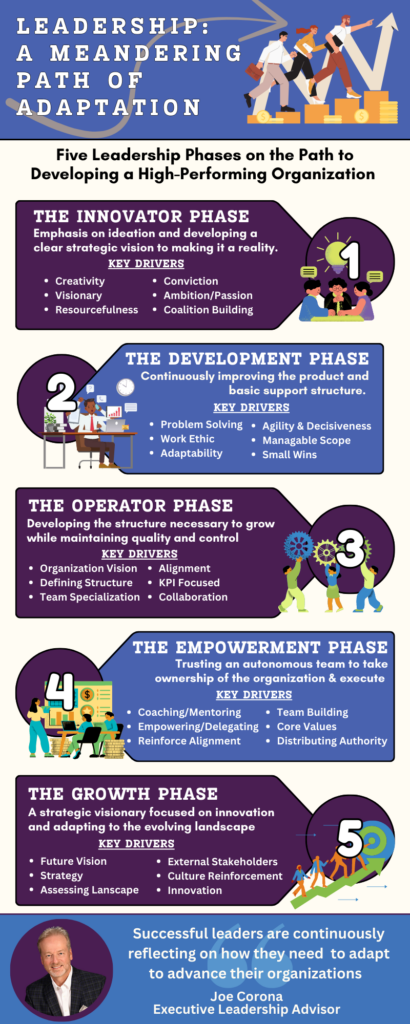Organizations are like living organisms, they evolve and change over time. As they do leaders encounter different opportunities and challenges along the way. The skills, behaviors, and priorities often need to evolve in order for the organization to adapt and grow. The most successful leaders strive to maintain awareness of their situation so they can recognize how best to adapt. Further, they have the courage and fortitude to make the difficult decisions even if it means changing their role and priorities. Here are a few examples.

It is well documented how deeply involved Jeff Bezos was in running Amazon in it’s early days. Whether it was preparing packages, negotiating contracts, or hiring personnel he did what ever needed to be done. It is the nature of leading a start-up organization. From the humble beginnings of running the online book store from a garage, Jeff experienced many of the same challenges founder’s often face; raising capital, overcoming leadership limitations, and financial distress, just to name a few. The one thing that kept driving him – his vision of where Amazon could go. He also recognized that in order to realize that vision he would have to evolve as a leader.

Howard Schultz joined Starbucks when it only had 4 stores. Upon his arrival he embraced strong core values that centered on taking care of customers and employees. The values provided a strong leadership foundation that enabled the company to experience rapid growth. When Starbucks grew to over 3,000 stores Howard realized that international markets were the next frontier. Knowing how strategically important it was for the company he stepped down from the CEO role to focus solely on international expansion. He recognized the future success of the company required him to evolve as a leader.

Sara Blakely’s great idea and drive resulted in her starting Spanx, a women’s clothing line, despite having no fashion, retail, or leadership experience. Her tenacity and willingness to fail scored her some big wins early and the company’s revenue took off. Sara soon recognized that if the company was going to continue to grow it needed more formality and structure. So she hired an experienced executive to replace her as CEO in only the second year of Spanx existence. Sara knew that if the company was going to scale successfully she needed to evolve and assume a different role.
Leading companies through growth stages is like preparing for different seasons. The leadership fundamentals generally remain the same, but how you apply them varies based on how the situation context evolves. The path to success starts with a compelling idea, but turning it into a successful venture requires keen situation awareness, the ability to recognized when change is necessary, and a strong desire to grow as a leader.
How Jeff Bezos led Amazon in 2018 was very different than how he led it in 2000. Starbucks might never have achieved international success had Howard Schultz not recognized the need to change his role. And perhaps Spanx might not have continued it’s hockey stick growth trajectory had Sara Blakely not recognized how important structure is to effectively scale the business.
Although these leader’s styles and approaches were different, they were all transformational in that they were willing to evolve because it was in the best interest of the organization. Having been through numerous start-ups myself, I have experienced very different circumstances that required me to adapt my leadership approach. Based on my experience and observations I have developed 5 leadership stages in the organization growth cycle and the corresponding leadership drivers that more directly address the context. When you are developing an organization the stages are generally not as straight forward and easy to identify as they are in the graphic. Sometimes the phases overlap, or evolve on different timelines. But you get the picture. Leading an organization through these cycles really is a meandering path of adaptation! What phase is your organization currently in?
